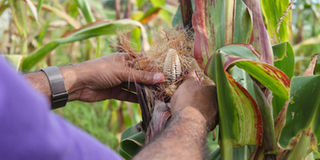Disease ravages maize crops

Corn on a farm outside Tabora, Tanzania
What you need to know:
The maize lethal necrosis disease (MLND), has ravaged fields in the north since 2013, and there are fears that it may head south.
Arusha. The ministry of Agriculture, Livestock and Fisheries Development has refuted reports that a disease ravaging maize farms in the northern zone will spill to the south.
The maize lethal necrosis disease (MLND), has ravaged fields in the north since 2013, and there are fears that it may head south.
“The disease observed in Rungwe is not MLND. It is Maize Streak Virus”, elaborated the acting director of Research and Development Dr Hussein Mansoor in a communication sent to experts within the ministry who sought clarification..
He added that although some parts of the southern highlands were highly infested by the Maize Streak Virus, there had not been reports of the outbreak of MLND there. The latter has largely been confined to the northern parts of the country.
Dr Mansoor said: “farmers are recycling their seeds that are susceptible to the disease. Farmers should use resistant seed varieties and they are readily available in the southern highlands.”
Earlier on, the spokesperson of the ministry Richard Kasuga claimed ignorance of the strange disease in Rungwe. He expected the Agricultural Research Institute (ARI) at Uyole in Mbeya to give the ministry feedback on the type of virus attacking maize crops in the area.
The Citizen reported late last year that maize farmers in Busokelo District in Rungwe District may lose 70 per cent of harvests this year due to the new disease that experts say has no cure.
The viral disease is spread by grasshoppers and was already posing a threat to food security in the area, according to the agricultural officer based there Gideon Mapunda.
According to him, the disease turns maize leaves white. The wards, already affected by the end of December last year were Kandete,Mpombo, Luteba, Isanga, Kabula and Lwangwa.
When reached for comment the principal agricultural researcher with the Arusha-based Selian Agricultural Research Institute (Sari) Dr Charles Lyamchai who is also the coordinator of MLND disease in the country said he was not aware of the new outbreak.
Other experts contacted said there were no reports that MLND had crossed over to the southern regions from the north.
Most affected regions are Arusha, Manyara, Kilimanjaro, Mara and Simiyu. The disease has also wreaked havoc in maize fields in Kenya since 2012, destroying at least 30 per cent of the maize yields.
During a field day organised by the ministry for maize farmers in Karatu last year, Dr Mansoor advised the farmers that since disease-resistant varieties against MLND were yet to be found, it was their responsibility to take extra precautions.
He called on farmers to uproot and burn the crops that have been infected by the disease and to ensure that they plant certified seeds. According to him,the disease is largely spread through the seeds.


